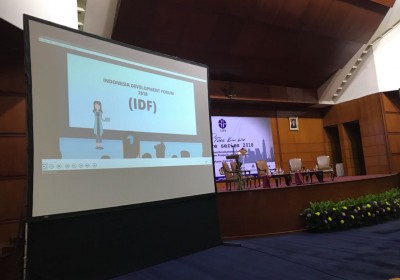Tackling Infrastructure Challenges As a Solution to Address Economic Inequality
May 02, 2018
The dissemination of the Call for Papers for the Indonesian Development Forum 2018 in the Road to IDF event “The Development Review Forum: the 3rd Thee Kian Wie Lecture Series in 2018”.
President Joko Widodo on various occasions often spoke of the importance of infrastructure development as an effort to accelerate equitable distribution of the development outcomes. Infrastructure will improve the quality of life, encourage regional economy, and reduce logistics costs.
Deputy for the Acceleration of Infrastructure and Regional Development of the Coordinating Ministry for Economic Affairs, Wahyu Utomo, said infrastructure development will establish new economic regions.
"Infrastructure development consists of two types, logistics and energy," Wahyu said, in his presentation titled "Infrastructure Development in Indonesia: Evaluation, Challenges and Prospects".
As part of the series of activities towards the Indonesia Development Forum 2018, P2E LIPI in cooperation with Knowledge Sector Initiative (KSI) held Road to IDF Development Assessment Forum: 3rd Thee Kian Wie Lecture Series 2018. The Road to IDF was held in Auditorium Hotel Bidakara, Jakarta on Wednesday, April 25 2018. The discussions therein were about steps to overcome infrastructure challenges in Indonesia.
The logistics and energy infrastructure will be the locomotive of development in the new energy area. The government believes, according to Wahyu, that border and remote areas often face development problems because of the very expensive cost of logistics and the minimal energy supply. As a result, infrastructure development is aimed at reducing logistics costs by providing roads and transportation facilities and strengthening the energy supply side to support irrigation for agriculture, power generation, and oil and gas production.
Development of logistics and energy infrastructure does not happen overnight. The government has set infrastructure development targets in the National Medium Term Development Plan (RPJMN) 2015-2019 in the form of National Strategic Project and Priority Project. This new infrastructure development will have long term and also short term impact.
The Head of the Center for the State Budget Policy of the Fiscal Policy Office of the Ministry of Finance, Hidayat Amir, said that infrastructure development has a short-term impact in the form of increased wages and salaries.
"The components of wages and salaries alone in infrastructure spending can increase household consumption and create new jobs," said Amir, who discussed the 20-Year Reflection of the Infrastructure Budgeting Politics in Indonesia.
Infrastructure spending is also considered more effective than social assistance or direct subsidies in reducing inequality. According to Amir, social assistance is able to increase household consumption, but it can also trigger an increase in inflation. On the other hand, subsidies can maintain price stability and encourage consumption, but the long-term impact will not be as significant as that of infrastructure spending.
Capital Expenditure Support
The government is committed to providing connectivity networks in all regions and trying to reduce economic disparities across the country. To run national strategic projects and priority projects, the total infrastructure budget needed in 2015-2019 reached Rp 4.197 trillion. Of these needs, 42 percent rely on the State Budget (APBN) and funds from state-owned enterprises (BUMN), while the remaining is expected to come from private investment.
The Deputy for the Acceleration of Infrastructure and Regional Development of the Coordinating Ministry for Economic Affairs, Wahyu Utomo, said there were 30 National Strategy Projects (PSN) completed until the end of 2017 with an investment value of Rp 94.8 trillion. In addition, there are 37 projects and 1 program under construction, which has been partially operational, the value of which amounts to Rp 1,478.9 trillion.
This large budget shows the need for investment in infrastructure to top up that from the state budget. Data from the Asian Development Bank in 2018 shows that infrastructure investment needs in Asian developing countries reach USD 26 trillion during 2016-2030. The average investment requirement per year reaches USD 1.7 trillion.
"As much as 85 percent of the value of this investment is used for the development of energy and transportation infrastructure," said economist from Australian National University Peter McCawley, citing data from the Asian Development Bank.
Therefore, McCawley said, the governments of Asian countries - including Indonesia - need to coordinate with stakeholders ranging from governments to private sector and consumers. In his presentation: “Reflection on Infrastructure Policy in Indonesia: lessons learned from ADB's financing projects in Indonesia and other countries,” McCawley said the Indonesian government needs to create a regulatory system that opens investment opportunities to provide funding necessary for infrastructure development.
Responding to this challenge, Wahyu said the government has been simplifying the licensing procedures for to improve ease of making investment. This policy refers to Presidential Regulation (Perpres) Number 91 Year 2017 on Promoting the Ease of Doing Business.
"This is because the government needs community participation to develop infrastructure and reduce economic inequality," said Wahyu when ending his presentation.
Indonesia’s Research Institutions Supporting the Development of the Electric Vehicle Industry
Indonesian Muslim Fashion and Cosmetics IKMs Shine at Dubai World Expo 2020
Govt Steps Up UMKM Transformation Efforts in the Midst of Pandemic Slowdown
Govt Encourages Promotion of IKM Products in Digital Era
Government Begins Developing Maritime Training Center in Makassar
Tweets by IDDevForum
